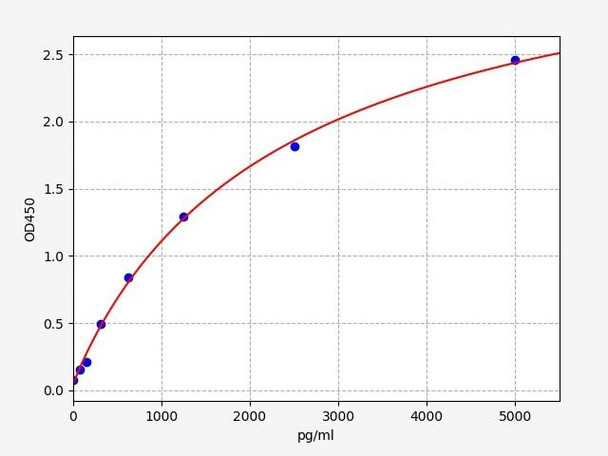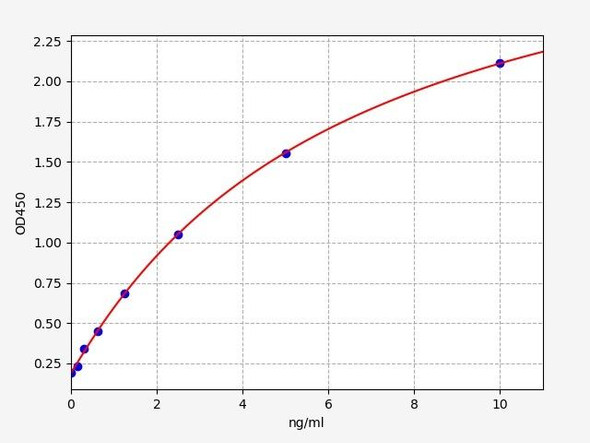Rat PDE4B / cAMP-specific 3',5'-cyclic phosphodiesterase 4B ELISA Kit (RTFI00191)
- SKU:
- RTFI00191
- Product Type:
- ELISA Kit
- Size:
- 96 Assays
- Uniprot:
- P14646
- Sensitivity:
- 46.875pg/ml
- Range:
- 78.125-5000pg/ml
- ELISA Type:
- Sandwich
- Synonyms:
- Pde4b,, DPDE4, PDE32, cAMP-specific 3', 5'-cyclic phosphodiesterase 4B
- Reactivity:
- Rat
Description
Rat PDE4B/cAMP-specific 3',5'-cyclic phosphodiesterase 4B ELISA Kit
The Rat PDE4B (cAMP-specific 3',5'-cyclic phosphodiesterase 4B) ELISA Kit is a powerful tool for measuring levels of PDE4B in rat samples with high accuracy and precision. This kit is specifically designed for detecting PDE4B levels in biological samples such as serum, plasma, and cell culture supernatants.PDE4B is an enzyme that plays a crucial role in regulating intracellular levels of cAMP, a key second messenger involved in various cellular processes. Dysregulation of PDE4B has been implicated in a range of diseases, including inflammatory disorders, neurological disorders, and cancer.
Studying PDE4B levels can provide valuable insights into disease mechanisms and potential therapeutic targets.With its high sensitivity and specificity, the Rat PDE4B ELISA Kit ensures reliable and reproducible results for your research needs. Whether you are investigating the role of PDE4B in disease pathogenesis or developing novel therapies targeting this enzyme, this kit is an essential tool for your laboratory experiments.
| Product Name: | Rat Pde4b (cAMP-specific 3?,5?-cyclic phosphodiesterase 4B) ELISA Kit |
| Product Code: | RTFI00191 |
| Size: | 96 Assays |
| Target: | Rat Pde4b |
| Alias: | Pde4b, DPDE4, PDE32, cAMP-specific 3', 5'-cyclic phosphodiesterase 4B |
| Reactivity: | Rat |
| Detection Method: | Sandwich ELISA, Double Antibody |
| Sensitivity: | 46.875pg/ml |
| Range: | 78.125-5000pg/ml |
| Storage: | 4°C for 6 months |
| Note: | For Research Use Only |
| Recovery: | Matrices listed below were spiked with certain level of Rat Pde4b and the recovery rates were calculated by comparing the measured value to the expected amount of Rat Pde4b in samples. | ||||||||||||||||
| |||||||||||||||||
| Linearity: | The linearity of the kit was assayed by testing samples spiked with appropriate concentration of Rat Pde4b and their serial dilutions. The results were demonstrated by the percentage of calculated concentration to the expected. | ||||||||||||||||
| |||||||||||||||||
| Intra-Assay: | CV <8% | ||||||||||||||||
| Inter-Assay: | CV <10% |
| Uniprot: | P14646 |
| UniProt Protein Function: | PDE4B: a cAMP-specific phosphodiesterase. May be involved in mediating central nervous system effects of therapeutic agents ranging from antidepressants to antiasthmatic and anti-inflammatory agents. Inhibited by rolipram. Three alternatively-spliced isoforms have been described. |
| UniProt Protein Details: | Protein type:EC 3.1.4.53; Nucleotide Metabolism - purine; Phosphodiesterase Chromosomal Location of Human Ortholog: 5q33 Cellular Component: cell periphery; centrosome; cytoplasm; cytosol; dendritic spine; excitatory synapse; gamma-tubulin complex; membrane; nucleus; perinuclear region of cytoplasm; postsynaptic density; synaptic vesicle; voltage-gated calcium channel complex; Z disc Molecular Function:3',5'-cyclic-AMP phosphodiesterase activity; 3',5'-cyclic-nucleotide phosphodiesterase activity; cAMP binding; gamma-tubulin binding; ion channel binding; metal ion binding Biological Process: cAMP catabolic process; cellular response to epinephrine stimulus; leukocyte migration; neutrophil chemotaxis; neutrophil homeostasis; positive regulation of interferon-gamma production; positive regulation of interleukin-2 production; regulation of cardiac muscle cell contraction; signal transduction; smooth muscle contraction; T cell receptor signaling pathway |
| NCBI Summary: | contains four isoforms expressed from the same gene; isoform Pde4b4 has cAMP specific phosphdiesterase activity and is inhibited by rolipram [RGD, Feb 2006] |
| UniProt Code: | P14646 |
| NCBI GenInfo Identifier: | 19923680 |
| NCBI Gene ID: | 24626 |
| NCBI Accession: | NP_058727.2 |
| UniProt Secondary Accession: | P14646,Q5RKL0, Q8VD81, Q8VD82, |
| UniProt Related Accession: | P14646 |
| Molecular Weight: | 81,737 Da |
| NCBI Full Name: | cAMP-specific 3',5'-cyclic phosphodiesterase 4B |
| NCBI Synonym Full Names: | phosphodiesterase 4B |
| NCBI Official Symbol: | Pde4b |
| NCBI Official Synonym Symbols: | Pde4B1; Pde4B2; Pde4B3; Pde4B4; Pde4b5; PDE4/IVb |
| NCBI Protein Information: | cAMP-specific 3',5'-cyclic phosphodiesterase 4B |
| UniProt Protein Name: | cAMP-specific 3',5'-cyclic phosphodiesterase 4B |
| UniProt Synonym Protein Names: | DPDE4 |
| Protein Family: | cAMP-specific 3',5'-cyclic phosphodiesterase |
| UniProt Gene Name: | Pde4b |
| Step | Procedure |
| 1. | Set standard, test sample and control (zero) wells on the pre-coated plate respectively, and then, record their positions. It is recommended to measure each standard and sample in duplicate. Wash plate 2 times before adding standard, sample and control (zero) wells! |
| 2. | Aliquot 0.1ml standard solutions into the standard wells. |
| 3. | Add 0.1 ml of Sample / Standard dilution buffer into the control (zero) well. |
| 4. | Add 0.1 ml of properly diluted sample ( Human serum, plasma, tissue homogenates and other biological fluids.) into test sample wells. |
| 5. | Seal the plate with a cover and incubate at 37°C for 90 min. |
| 6. | Remove the cover and discard the plate content, clap the plate on the absorbent filter papers or other absorbent material. Do NOT let the wells completely dry at any time. Wash plate X2. |
| 7. | Add 0.1 ml of Biotin- detection antibody working solution into the above wells (standard, test sample & zero wells). Add the solution at the bottom of each well without touching the side wall. |
| 8. | Seal the plate with a cover and incubate at 37°C for 60 min. |
| 9. | Remove the cover, and wash plate 3 times with Wash buffer. Let wash buffer rest in wells for 1 min between each wash. |
| 10. | Add 0.1 ml of SABC working solution into each well, cover the plate and incubate at 37°C for 30 min. |
| 11. | Remove the cover and wash plate 5 times with Wash buffer, and each time let the wash buffer stay in the wells for 1-2 min. |
| 12. | Add 90 µL of TMB substrate into each well, cover the plate and incubate at 37°C in dark within 10-20 min. (Note: This incubation time is for reference use only, the optimal time should be determined by end user.) And the shades of blue can be seen in the first 3-4 wells (with most concentrated standard solutions), the other wells show no obvious color. |
| 13. | Add 50 µL of Stop solution into each well and mix thoroughly. The color changes into yellow immediately. |
| 14. | Read the O.D. absorbance at 450 nm in a microplate reader immediately after adding the stop solution. |
When carrying out an ELISA assay it is important to prepare your samples in order to achieve the best possible results. Below we have a list of procedures for the preparation of samples for different sample types.
| Sample Type | Protocol |
| Serum: | If using serum separator tubes, allow samples to clot for 30 minutes at room temperature. Centrifuge for 10 minutes at 1,000x g. Collect the serum fraction and assay promptly or aliquot and store the samples at -80°C. Avoid multiple freeze-thaw cycles. If serum separator tubes are not being used, allow samples to clotovernight at 2-8°C. Centrifuge for 10 minutes at 1,000x g. Removeserum and assay promptly or aliquot and store the samples at-80°C. Avoid multiple freeze-thaw cycles. |
| Plasma: | Collect plasma using EDTA or heparin as an anti-coagulant. Centrifuge samples at 4°C for 15 mins at 1000 × g within 30 mins of collection. Collect the plasma fraction and assay promptly or aliquot and store the samples at -80°C. Avoid multiple freeze-thaw cycles.Note: Over haemolysed samples are not suitable for use with this kit. |
| Urine & Cerebrospinal Fluid: | Collect the urine (mid-stream) in a sterile container, centrifuge for 20 mins at 2000-3000 rpm. Remove supernatant and assay immediately. If any precipitation is detected, repeat the centrifugation step. A similar protocol can be used for cerebrospinal fluid. |
| Cell Culture Supernatant: | Collect the cell culture media by pipette, followed by centrifugation at 4°C for 20 mins at 1500 rpm. Collect the clear supernatant and assay immediately. |
| Cell Lysates: | Solubilize cells in lysis buffer and allow to sit on ice for 30 minutes. Centrifuge tubes at 14,000 x g for 5 minutes to remove insoluble material. Aliquot the supernatant into a new tube and discard the remaining whole cell extract. Quantify total protein concentration using a total protein assay. Assay immediately or aliquot and store at ≤ -20°C. |
| Tissue Homogenates: | The preparation of tissue homogenates will vary depending upon tissue type. Rinse tissue with 1X PBS to remove excess blood & homogenizein 20ml of 1X PBS (including protease inhibitors) and store overnight at ≤ -20°C. Two freeze-thaw cycles are required to break the cell membranes. To further disrupt the cell membranes you can sonicate the samples. Centrifuge homogenates for 5 mins at 5000xg. Remove the supernatant and assay immediately or aliquot and store at -20°C or-80°C. |
| Tissue Lysates: | Rinse tissue with PBS, cut into 1-2 mm pieces, and homogenize with a tissue homogenizer in PBS. Add an equal volume of RIPA buffer containing protease inhibitors and lyse tissues at room temperature for 30 minutes with gentle agitation. Centrifuge to remove debris. Quantify total protein concentration using a total protein assay. Assay immediately or aliquot and store at ≤ -20 °C. |
| Breast Milk: | Collect milk samples and centrifuge at 10,000 x g for 60 min at 4°C. Aliquot the supernatant and assay. For long term use, store samples at -80°C. Minimize freeze/thaw cycles. |






